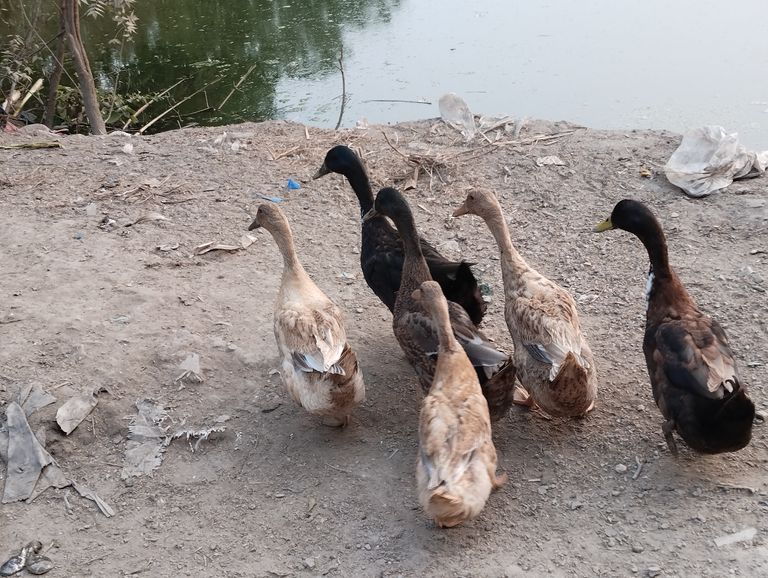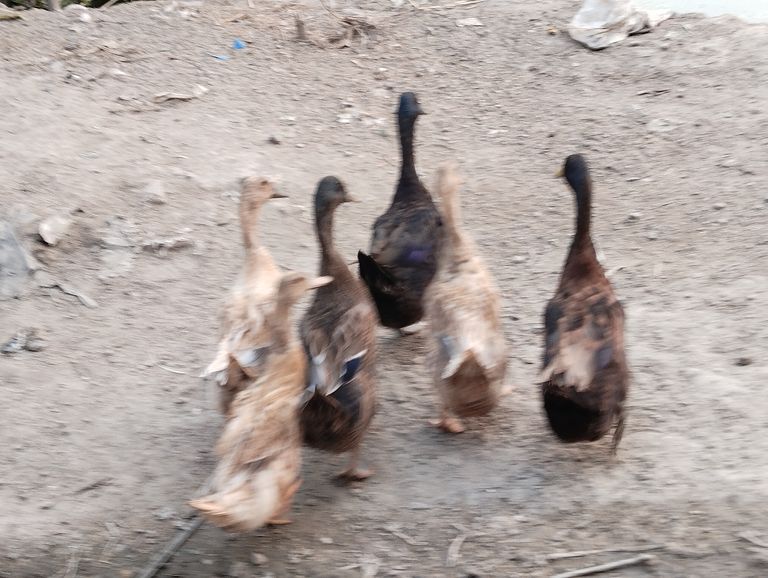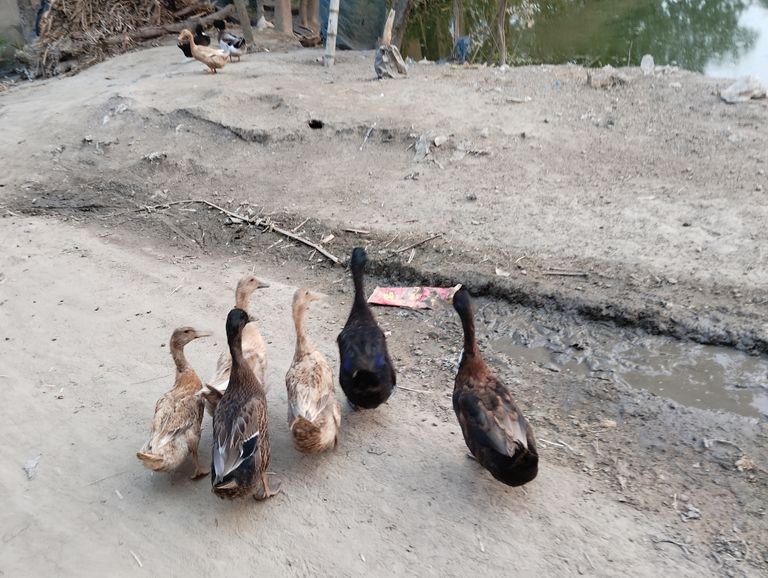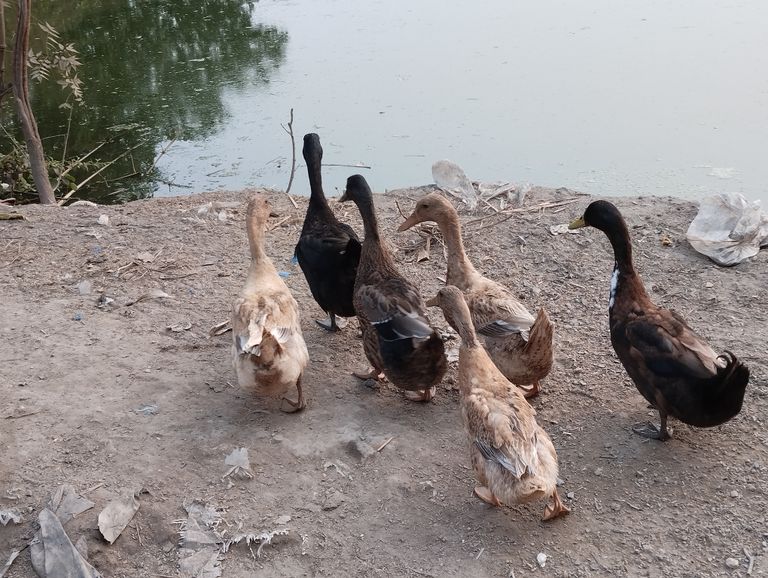
Rearing Domestic Ducks in Ponds A Complete Guide.
Duck farming is a profitable and sustainable agricultural practice, especially when done in natural water bodies like ponds. Domestic ducks (commonly known as "Pati Hans" in Bengali) are easy to rear, require minimal care, and provide multiple benefits such as meat, eggs, and natural pest control. This blog will guide you through everything you need to know about raising ducks in ponds, from selecting the right breed to managing feeding, healthcare, and profitability.
- Advantages of Rearing Ducks in Ponds
Rearing ducks in ponds has several benefits compared to other poultry farming methods:
Low Investment: Ducks require less capital compared to chickens or other livestock.
Natural Habitat: Ponds provide ducks with their ideal environment, reducing stress and increasing productivity.
Pest Control: Ducks eat insects, snails, and algae, keeping the pond ecosystem balanced.
Sustainable Farming: Duck droppings enrich pond water, benefiting fish farming (integrated farming system).
Dual Income Source: Ducks provide eggs and meat, offering a continuous source of income.
- Selecting the Right Duck Breed
The success of duck farming depends largely on choosing the right breed. Here are some popular duck breeds for pond rearing:
Khaki Campbell: Known for high egg production (250-300 eggs per year).
Indian Runner: Excellent foragers and good egg layers (200-250 eggs per year).
Pekin Duck: Popular for meat production, fast-growing with a high feed-to-meat conversion rate.
Muscovy Duck: Quiet, disease-resistant, and suitable for both meat and eggs.
Desi or Indigenous Ducks: Adapt well to local conditions and require minimal care.
- Setting Up a Duck Farm in a Pond
A well-planned farm setup ensures high productivity and low mortality. Follow these steps:
a. Selecting a Suitable Pond
Choose a pond with clean and fresh water to prevent diseases.
The ideal pond size depends on the number of ducks; for 100 ducks, a pond of at least 5-10 decimal (0.05-0.1 acre) is recommended.
Ensure gentle slopes so ducks can easily enter and exit the water.
b. Building a Shelter
Ducks need a safe and dry place to rest at night. Consider the following:
Construct a shed near the pond using bamboo, wood, or tin sheets.
Ensure proper ventilation to prevent respiratory diseases.
Provide nesting boxes (1 box per 5 ducks) for egg-laying breeds.
The floor should be raised to keep it dry and covered with straw or sawdust.
- Feeding and Nutrition
Ducks are natural foragers, but additional feeding ensures better growth and egg production.
a. Natural Diet from Pond
Algae, snails, small fish, and aquatic plants provide natural nutrition.
Ducks also eat insects and leftover grains, reducing feeding costs.
b. Supplementary Feed
Provide a balanced diet of grains (rice, wheat, maize), oilseeds, and protein sources (fish meal, soybean meal).
Ducklings need starter feed (18-20% protein), while adult ducks require layer or grower feed (16-18% protein).
Ducks also need calcium (oyster shells, limestone) to improve eggshell quality.
c. Feeding Schedule
Feed ducklings 4-5 times a day and adult ducks twice daily.
Provide fresh, clean water at all times.
- Health Management and Disease Control
Ducks are generally hardy, but proper healthcare is essential to prevent diseases.
a. Common Duck Diseases & Prevention
b. Biosecurity Measures
Keep the farm clean and dry to prevent bacterial growth.
Vaccinate ducks against common diseases.
Avoid overcrowding, as it spreads infections.
Quarantine newly purchased ducks for at least a week before introducing them to the flock.
- Breeding and Egg Production
For continuous egg production and breeding, follow these tips:
Provide nesting boxes with clean straw for egg-laying.
Maintain male-to-female ratio (1 male per 5-6 females for breeding).
Collect eggs daily to prevent breakage and contamination.
Incubation: Use an incubator or allow a broody duck to hatch eggs naturally.
Ducks start laying eggs at 5-6 months and can lay for up to 2-3 years.
- Market Opportunities and Profitability
Duck farming is a lucrative business with high demand for both eggs and meat.
a. Selling Duck Products
Eggs: Sell fresh eggs in local markets or supply to retailers.
Meat: Pekin and Muscovy ducks have high demand in hotels and restaurants.
Ducklings: Hatch and sell ducklings to other farmers.
Manure: Duck droppings can be used as organic fertilizer or fish feed.
b. Profit Calculation (Example for 100 Ducks)
- Integrated Duck Farming (Duck-Fish Farming)
To maximize profits, many farmers practice integrated duck-fish farming, where:
Duck droppings fertilize the pond, boosting fish growth.
Ducks feed on pond insects and algae, reducing fish feed costs.
This method increases overall farm productivity with minimal extra investment.
Pond-based duck farming is a low-cost, high-profit venture suitable for both small and large-scale farmers. With proper planning, feeding, and disease management, duck farming can provide a steady income. Whether you're looking to start small or expand into an integrated farming system, duck farming in ponds is a sustainable and rewarding agricultural practice.
Are you interested in starting your own duck farm? Share your thoughts or questions in the comments below.

Complete Guide to Domestic Duck Feed
Domestic ducks, commonly known as Pati Hans in Bengali, are popular for their eggs, meat, and as farm animals. Proper feeding is crucial for their health, productivity, and overall well-being. This guide provides a detailed overview of domestic duck feed, including types of food, nutritional requirements, feeding schedules, and tips for maximizing their growth and egg production.
Nutritional Requirements of Domestic Ducks
Like all poultry, ducks require a balanced diet that includes:
- Carbohydrates – Provides energy (corn, wheat, rice bran).
- Proteins – Essential for growth and egg production (soybean meal, fish meal, worms, insects).
- Fats – Helps in energy storage and maintaining body temperature (vegetable oil, fish oil).
- Vitamins and Minerals – Strengthens immunity and improves overall health (leafy greens, commercial supplements, oyster shells).
- Water – Ducks need plenty of fresh, clean water for digestion and overall well-being.
Types of Feed for Domestic Ducks
- Starter Feed (0-4 Weeks Old)
Newly hatched ducklings require protein-rich feed (18-20% protein).
Ideal starter feed: Crushed grains, soybean meal, chick starter feed, boiled eggs, and finely chopped greens.
Avoid medicated chick starter as some additives are toxic to ducklings.
- Grower Feed (4-18 Weeks Old)
Protein level: 14-16% for proper growth.
Feed type: Corn, wheat, rice bran, fish meal, soybean meal, and green vegetables.
Ducks at this stage also start foraging for worms and insects.
- Layer Feed (For Egg-Laying Ducks, 18+ Weeks)
Protein level: 16-18% to support egg production.
Rich in calcium for strong eggshells (oyster shells, limestone, bone meal).
Feed type: Layer pellets, crushed grains, greens, and calcium supplements.
- Meat Ducks (Broilers) Feed
Protein requirement: 18-20% for fast growth.
Feed type: High-energy commercial broiler feed, fish meal, soybean meal, and corn.
Ducks raised for meat are fed ad libitum (free feeding) for faster weight gain.
Natural and Homemade Duck Feed
Many farmers prefer to provide a natural diet to their ducks to reduce costs and improve health. Here are some common natural feed options:
Grains and Seeds
Rice bran
Broken rice
Corn
Wheat
Sorghum
Protein Sources
Earthworms
Snails
Insects
Small fish
Boiled eggs
Vegetables and Greens
Water spinach
Duckweed
Lettuce
Cabbage
Azolla (a floating aquatic plant rich in protein)
Calcium and Minerals
Crushed eggshells
Oyster shells
Limestone powder
Bone meal
Feeding Schedule for Ducks
Tips for Feeding Ducks Efficiently
- Provide fresh water – Ducks drink a lot of water and need it for digestion.
- Avoid moldy food – Spoiled feed can cause diseases.
- Balance nutrients – Ensure proper protein, calcium, and vitamins.
- Let ducks forage – Free-ranging helps reduce feed costs and improves nutrition.
- Supplement during winter – Ducks need more energy-rich food in cold weather.
Common Mistakes to Avoid
Feeding only rice or wheat – Ducks need protein and greens, not just grains.
Giving too much bread – Bread lacks essential nutrients and can cause digestive issues.
Using medicated feed – Some poultry feeds contain additives harmful to ducks.
Not providing grit – Ducks need grit or small stones to help digest food.
A balanced diet is essential for raising healthy and productive domestic ducks. Whether for eggs, meat, or as pets, ducks thrive on a mix of grains, proteins, greens, and fresh water. By following the right feeding schedule and avoiding common mistakes, you can ensure your ducks stay healthy and productive. Would you like more details on duck farming, housing, or disease prevention? Let me know.

How to Build a Duck House for Domestic Ducks
Ducks are a great addition to any backyard or farm. They provide eggs, meat, and pest control while being easy to care for. However, to keep them safe and healthy, you need a proper duck house. In this blog, we will guide you on how to build a simple and effective duck house for domestic ducks.
Why Do Ducks Need a House?
Ducks are hardy birds, but they still need shelter to protect them from predators, harsh weather, and provide a comfortable place to rest and lay eggs. A well-designed duck house ensures:
Protection from predators like foxes, raccoons, and dogs
Shelter from rain, wind, and extreme temperatures
A clean and dry area for resting and laying eggs
A secure place to keep ducks safe at night
Things to Consider Before Building a Duck House
Before you start building, consider the following factors:
- Size: A duck house should provide at least 3–4 square feet per duck inside the shelter and 10 square feet per duck in an outdoor run.
- Ventilation: Ducks produce a lot of moisture and ammonia. Proper ventilation is necessary to keep the air fresh.
- Easy Cleaning: The house should be designed for easy access and cleaning. A wide door or a removable floor helps in maintenance.
- Predator Protection: The house should be secure with strong wire mesh to keep predators out.
- Weather Resistance: The house should be waterproof and insulated for extreme weather conditions.
Materials Needed to Build a Duck House
Wooden planks or plywood
Nails and screws
Hinges for doors
Wire mesh (for windows and ventilation)
Roofing materials (metal sheets, shingles, or waterproof tarpaulin)
Saw, hammer, and drill
Paint or wood sealant (optional, for weather protection)
Step-by-Step Guide to Building a Duck House
Step 1: Choose a Location
Select a dry, well-drained area for your duck house. Avoid low-lying areas where water collects, as ducks need a dry place to sleep.
Step 2: Design the Duck House
A simple rectangular wooden structure with a slanted roof works well.
Plan a door for easy access and cleaning.
Include windows or ventilation holes covered with wire mesh.
Step 3: Build the Frame
- Use wooden planks to create a rectangular frame.
- Secure the base of the house slightly elevated (around 6 inches) to prevent flooding.
Step 4: Attach Walls and Roof
- Nail or screw plywood sheets to the frame for walls.
- Create a slanted roof using metal sheets or waterproof wood to allow rain to slide off.
Step 5: Install Doors and Windows
Add a main door large enough for easy cleaning.
Include a small duck-sized door for entry and exit.
Cover ventilation openings with wire mesh to keep predators out.
Step 6: Create a Comfortable Floor
Use straw, hay, or wood shavings for bedding.
Ensure the flooring is non-slippery and easy to clean.
Step 7: Add an Outdoor Run
If ducks cannot free-range, build a fenced run using strong wire mesh.
The run should be at least 3 feet high to prevent ducks from flying out.
Additional Tips for Maintaining a Duck House
- Clean Regularly: Remove wet bedding and replace with dry straw or wood shavings.
- Provide Fresh Water: Ducks need clean drinking water and a small pool for swimming.
- Ensure Proper Drainage: A muddy duck house leads to health issues. Keep the area dry.
- Secure at Night: Always lock the house at night to protect ducks from predators.
- Check for Damage: Inspect for holes, broken mesh, or weak spots regularly.
Final Thoughts
Building a duck house is an essential step in keeping your ducks healthy and safe. With proper planning and materials, you can create a cozy and secure home for your ducks. Whether you are a backyard farmer or a beginner, this guide will help you build the perfect duck house for your flock. Would you like to add any specific features to your duck house design? Let us know in the comments.

How to Build a Duck House for Domestic Ducks
Ducks are a great addition to any backyard or farm. They provide eggs, meat, and pest control while being easy to care for. However, to keep them safe and healthy, you need a proper duck house. In this blog, we will guide you on how to build a simple and effective duck house for domestic ducks.
Why Do Ducks Need a House?
Ducks are hardy birds, but they still need shelter to protect them from predators, harsh weather, and provide a comfortable place to rest and lay eggs. A well-designed duck house ensures:
Protection from predators like foxes, raccoons, and dogs
Shelter from rain, wind, and extreme temperatures
A clean and dry area for resting and laying eggs
A secure place to keep ducks safe at night
Things to Consider Before Building a Duck House
Before you start building, consider the following factors:
- Size: A duck house should provide at least 3–4 square feet per duck inside the shelter and 10 square feet per duck in an outdoor run.
- Ventilation: Ducks produce a lot of moisture and ammonia. Proper ventilation is necessary to keep the air fresh.
- Easy Cleaning: The house should be designed for easy access and cleaning. A wide door or a removable floor helps in maintenance.
- Predator Protection: The house should be secure with strong wire mesh to keep predators out.
- Weather Resistance: The house should be waterproof and insulated for extreme weather conditions.
Materials Needed to Build a Duck House
Wooden planks or plywood
Nails and screws
Hinges for doors
Wire mesh (for windows and ventilation)
Roofing materials (metal sheets, shingles, or waterproof tarpaulin)
Saw, hammer, and drill
Paint or wood sealant (optional, for weather protection)
Step-by-Step Guide to Building a Duck House
Step 1: Choose a Location
Select a dry, well-drained area for your duck house. Avoid low-lying areas where water collects, as ducks need a dry place to sleep.
Step 2: Design the Duck House
A simple rectangular wooden structure with a slanted roof works well.
Plan a door for easy access and cleaning.
Include windows or ventilation holes covered with wire mesh.
Step 3: Build the Frame
- Use wooden planks to create a rectangular frame.
- Secure the base of the house slightly elevated (around 6 inches) to prevent flooding.
Step 4: Attach Walls and Roof
- Nail or screw plywood sheets to the frame for walls.
- Create a slanted roof using metal sheets or waterproof wood to allow rain to slide off.
Step 5: Install Doors and Windows
Add a main door large enough for easy cleaning.
Include a small duck-sized door for entry and exit.
Cover ventilation openings with wire mesh to keep predators out.
Step 6: Create a Comfortable Floor
Use straw, hay, or wood shavings for bedding.
Ensure the flooring is non-slippery and easy to clean.
Step 7: Add an Outdoor Run
If ducks cannot free-range, build a fenced run using strong wire mesh.
The run should be at least 3 feet high to prevent ducks from flying out.
Additional Tips for Maintaining a Duck House
- Clean Regularly: Remove wet bedding and replace with dry straw or wood shavings.
- Provide Fresh Water: Ducks need clean drinking water and a small pool for swimming.
- Ensure Proper Drainage: A muddy duck house leads to health issues. Keep the area dry.
- Secure at Night: Always lock the house at night to protect ducks from predators.
- Check for Damage: Inspect for holes, broken mesh, or weak spots regularly.
Final Thoughts
Building a duck house is an essential step in keeping your ducks healthy and safe. With proper planning and materials, you can create a cozy and secure home for your ducks. Whether you are a backyard farmer or a beginner, this guide will help you build the perfect duck house for your flock.
Medicinal Benefits of Domestic Duck Meat
Duck meat is not only a delicious source of protein but also has significant medicinal properties. In many traditional medicine systems, especially in Asian cultures, duck meat is considered beneficial for various health conditions. This blog explores the medicinal benefits of domestic duck meat and how it can contribute to overall well-being.
Nutritional Profile of Duck Meat
Before diving into its medicinal benefits, let's take a look at the nutritional composition of duck meat:
Rich in High-Quality Protein: Duck meat contains essential amino acids that support muscle growth and repair.
High in Healthy Fats: Unlike chicken, duck meat contains more monounsaturated and polyunsaturated fats, which help maintain good heart health.
Rich in Vitamins and Minerals: It is an excellent source of B vitamins (B6, B12, niacin), iron, zinc, phosphorus, and selenium, all of which are essential for various bodily functions.
Medicinal Benefits of Domestic Duck Meat
- Boosts Immunity
Duck meat is rich in zinc and selenium, both of which play a crucial role in strengthening the immune system. These minerals help the body fight off infections and improve overall immunity.
- Good for Anemia Patients
Duck meat is an excellent source of iron, which is essential for red blood cell production. People suffering from anemia can benefit from consuming duck meat as it helps prevent fatigue, dizziness, and weakness caused by iron deficiency.
- Supports Heart Health
Though duck meat contains fat, it is mostly healthy unsaturated fat, which helps regulate cholesterol levels. The omega-3 and omega-6 fatty acids in duck meat can reduce inflammation and lower the risk of heart disease.
- Strengthens Bones and Joints
Duck meat is packed with phosphorus and calcium, two minerals crucial for maintaining strong bones and joints. Regular consumption of duck meat can help prevent osteoporosis and other bone-related issues.
- Enhances Brain Function
The high content of B vitamins, especially B6 and B12, supports brain function and improves cognitive abilities. These vitamins help in the production of neurotransmitters, which are essential for memory and concentration.
- Supports Skin and Hair Health
The presence of healthy fats and vitamins in duck meat makes it beneficial for skin and hair health. Vitamin B3 (niacin) in duck meat promotes skin elasticity, while the essential fatty acids help in maintaining shiny and strong hair.
- Helps in Recovery from Illness
In traditional medicine, duck meat is often recommended for people recovering from long-term illnesses or surgeries. It provides essential nutrients that help in faster recovery and replenishing lost energy.
- Improves Metabolism
Duck meat contains a high amount of niacin, which is essential for energy production and metabolism. It helps convert carbohydrates into energy, keeping the body active and reducing fatigue.
- Beneficial for Respiratory Health
Traditional Chinese medicine considers duck meat to be beneficial for respiratory conditions like asthma, bronchitis, and chronic cough. It is believed to have a cooling effect on the body, helping relieve inflammation in the respiratory tract.